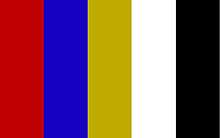Obangsaek
The traditional Korean color spectrum, also known as Obangsaek (오방색, means five-orientation-color), is the color scheme of the five Korean traditional colors of white, black, blue, yellow and red.[1][2] In Korean traditional arts and traditional textile patterns, the colors of Obangsaek represent five cardinal directions:[1]Obangsaek theory is a combination of Five Elements and Five Colours theory and originated in China.
| Obangsaek | |
 The five cardinal colors of the traditional Korean color spectrum | |
| Korean name | |
|---|---|
| Hangul | 오방색 |
| Hanja | |
| Revised Romanization | Obangsaek |
| McCune–Reischauer | Obangsaek |
Five orientations
- Blue: east
- Red: south
- Yellow: center
- White: west
- Black: north
These colors are also associated with the Five Elements of traditional Korean culture:[1]
- Blue: Wood
- Red: Fire
- Yellow: Earth
- White: Metal
- Black: Water
gollark: If one pixel is revolutionary surely zero pixels is even more so.
gollark: Oh yes, their CPU design teams are ridiculously good.
gollark: Which is kind of valuable.
gollark: They mostly just had more polished versions of existing products?
gollark: Nonzero ≠ worth caring about.
References
- "The Five Cardinal Colors of Traditional Patterns". AsianInfo.org. Retrieved 29 April 2015.
- Yoo, Jee-ho (3 May 2013). "Pyeongchang unveils emblem for 2018 Winter Olympics". Yonghap News Agency. Retrieved 29 April 2015.
This article is issued from Wikipedia. The text is licensed under Creative Commons - Attribution - Sharealike. Additional terms may apply for the media files.